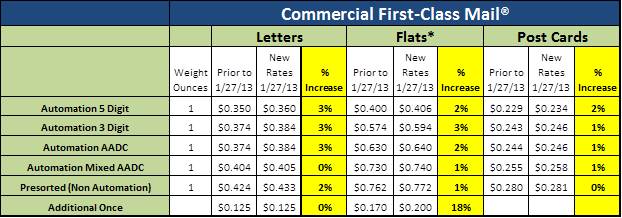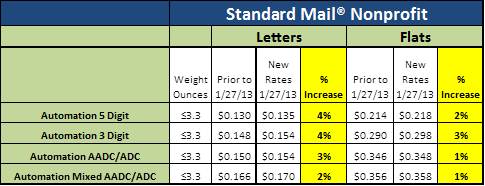I am writing this article right after inspecting my yard for damages after Hurricane Sandy. I had some large branches down that need to be cleaned up, but overall felt I pretty lucky. I have to equate this to the proposed January 2013 USPS price increase. The USPS is having a storm of its own in the form of reduced mail volumes, huge deficits, plant closures and potential slowdowns in service levels. With these headwinds, we could have had a huge price increase, but when looking at the details of the proposed rates, we may have all gotten off easy.
Overall, prices are expected to go up by 2-3%. Let us start out by saying these are the proposed rates that are to go into effect on January 27, 2013. The Postal Regulatory Commission has a comments period that extends until November 23, 2012 where these recommendations could be modified. Typically the final rates are very close to what is being proposed.
Postal rates are supposed to be tied to the Consumer Price Index which is running in the 2-3% range. The USPS needs their rates to be in line with this index except in the following circumstances:
1. Unused Rate Adjustment -- They did not adjust past rates to the full levels allowed.
2. Exigent Circumstances - They have drastic conditions that require them to raise rates to higher levels. This is our big worry because anyone could argue that we have justification for larger increases.
For the past 15 years, I have been creating comparison charts for my clients that go over the changes in rates to show how it will affect their budgets. The reason that I do this is that when the USPS talks about a 2-3% increase, this is overall. Based on the type of mail you do, the increase could be higher or lower. You need to look at the class, weight, zone, density and special services required to see the true impact. Also, when you look at the new rate charts provided by the USPS, they typically will not show the level of detail needed (Previous and new rates side by side) to see these differences.
The remainder of this article is to pull out areas where the increases are going to be higher or lower than the averages and how the changes will affect you.
First-Class Mail®
Retail
Overall, prices are expected to go up by 2-3%. Let us start out by saying these are the proposed rates that are to go into effect on January 27, 2013. The Postal Regulatory Commission has a comments period that extends until November 23, 2012 where these recommendations could be modified. Typically the final rates are very close to what is being proposed.
Postal rates are supposed to be tied to the Consumer Price Index which is running in the 2-3% range. The USPS needs their rates to be in line with this index except in the following circumstances:
1. Unused Rate Adjustment -- They did not adjust past rates to the full levels allowed.
2. Exigent Circumstances - They have drastic conditions that require them to raise rates to higher levels. This is our big worry because anyone could argue that we have justification for larger increases.
For the past 15 years, I have been creating comparison charts for my clients that go over the changes in rates to show how it will affect their budgets. The reason that I do this is that when the USPS talks about a 2-3% increase, this is overall. Based on the type of mail you do, the increase could be higher or lower. You need to look at the class, weight, zone, density and special services required to see the true impact. Also, when you look at the new rate charts provided by the USPS, they typically will not show the level of detail needed (Previous and new rates side by side) to see these differences.
The remainder of this article is to pull out areas where the increases are going to be higher or lower than the averages and how the changes will affect you.
First-Class Mail®
Retail

As you can see from the charts, letters and post cards are going up $.01 and flats are increasing by $.02 (1-2% increase). The big news is with First Class Parcels, which are going up 3-6%. I am going to guess this is because of the popularity of this service with e-commerce. The USPS is the only game in town for residential shipments that are less than a pound. Even with the increase, being able to ship a 6 ounce parcel for $2.58 including Delivery Confirmation at no charge is still huge bargain.

The price change range from 1-3%, with the largest increases are at the 5 digit levels. This is different from the norm where they are on the pieces with the least density. The big news is the additional ounce rate for flats increasing for $.17 to $.20 per piece (an 18% increase). This $.03 may not seem like a big deal, but if you are sending a 7 ounce, 3-digit, automation flat, your price increases goes from $1.594 to $1.794 or 13%.
Standard Mail


Overall rates have increased by 1-4%. Again I find it strange that the highest increases occurred for the higher sort levels where they are typically offering greater incentives. It appears that the entry level discounts for letters and flats remain unchanged.
Shipping Services

It is very difficult to compare rates for shipping services because you need to factor weight, zone, size and level of service into the equation. There is no way to give you a comparison on all of these, so I am highlighting three different common weight and zone groupings for Priority and Express Mail. We are using Commercial Base Rates, which are what you can expect to use through a Postage Meter, PC Postage or from USPS.com. As you can see from the table, the rates have increased from 2-8%.
Special Services

There are a couple of interesting points that are worthy of bringing up around special services:
1. Certified Mail with Return Receipt -- Retail increases from $5.30 to $5.65 (7% increase) and with Electronic Notification from $4.10 to $4.35 (6% increase).
2. Retail Delivery Confirmation on Priority Mail -- It used to be $.75 each and is proposed to be FREE!
Overall if you were to increase your budget by 3% for 2013 you should be safe. It is impossible to compare every rate but these are the most common mail classes used by business mailers throughout the United States. Hopefully from this overview you can see that we all got spared from a potential postal hurricane that could have been devastating for all of our budgets.
Adam Lewenberg, CMDSS is President of Postal Advocate Inc. with over 19 years of experience in the mail industry. Their mission is to help entities with large numbers of locations reduce mail related expenses, recover lost postage funds, and make their spends easy to manage. He can be reached at (617)372-8653 or adam.lewenberg@postaladvocate.com
1. Certified Mail with Return Receipt -- Retail increases from $5.30 to $5.65 (7% increase) and with Electronic Notification from $4.10 to $4.35 (6% increase).
2. Retail Delivery Confirmation on Priority Mail -- It used to be $.75 each and is proposed to be FREE!
Overall if you were to increase your budget by 3% for 2013 you should be safe. It is impossible to compare every rate but these are the most common mail classes used by business mailers throughout the United States. Hopefully from this overview you can see that we all got spared from a potential postal hurricane that could have been devastating for all of our budgets.
Adam Lewenberg, CMDSS is President of Postal Advocate Inc. with over 19 years of experience in the mail industry. Their mission is to help entities with large numbers of locations reduce mail related expenses, recover lost postage funds, and make their spends easy to manage. He can be reached at (617)372-8653 or adam.lewenberg@postaladvocate.com














